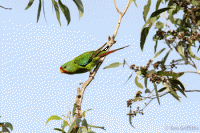Largest flock of rare parrot ever seen feeding in Royal National Park
A flock of one of the most endangered parrots in Australia, the Swift Parrot, has been spotted feeding in Royal National Park with experts saying it is the largest number ever recorded together in the park.
The spectacular sighting reinforces the importance of our national parks and is particularly exciting as Australia gets set to host the prestigious IUCN World Parks Congress this November which focusses attention on some of the most valuable landscapes in the world, protected areas, which provide vital habitat for millions of threatened species across the globe.
The Office of Environment and Heritage (OEH) Senior Natural Heritage Officer Debbie Andrew said with less than 1000 breeding pairs thought to be remaining in the wild across the entire country this sighting is incredibly significant.
“A single group of 30 is a major sighting for this very rare bird and it was made by local bird watcher Steve Anyon-Smith,” Ms Andrew said.
“The parrots are feeding on the nectar of flowering Heath Banksia and lerps on Scribbly Gums in the park and would be just returning from their Tasmanian summer breeding areas.
“This is also incredibly good timing with the Birdlife Australia National Census for Swift Parrots and Regent Honey Eaters occurring in mid-May,” she said.
The Swift Parrot is a small bright green fast flying parrot that can be distinguished from small lorikeets, such as the Little and Musk Lorikeets, by its long tail and red plumage – both under the wing and under the tail.
Swift Parrots feed on the nectar of eucalypts and other native shrubs and the sugary secretions of sap sucking insects called lerps.
Ms Andrew said the parrots are migratory and breed in the Tasmanian Blue Gum forests of eastern Tasmania over summer then fly across Bass Strait to the south-eastern Australian mainland for autumn and winter where they search for local abundances of flowering eucalypts and lerps.
“Their locations on the mainland vary year to year in response to the availability of nectar and the irregularities on the flowering patterns of eucalypts,” Ms Andrew said.
“It’s obviously a good year for Royal with such a large number visiting the area to feed.
“In some years they may be found in the eucalypt Box woodlands of the western slopes when White Box, Grey Box or Mugga Ironbark are in heavy flower. In other years they may appear in coastal forests in flowering Spotted Gum, Swamp Mahogany, Forest Red Gum or Red Bloodwood such as the NSW south coast or central coast.”
On the weekend of the 17th and 18th May the Birdlife Australia National Swift Parrot and Regent Honeyeater census will be undertaken across south-eastern Australia with records of these two highly threatened nectar feeding birds being sought from local bird watchers and interested members of the public.
Information on the survey and survey forms can be obtained from the Birdlife Australia website – part of Birdlife Australia’s Woodland Birds for Biodiversity project: www.birdlife.org.au.
The Swift Parrot is listed as Endangered under both NSW and Federal threatened species Acts.







